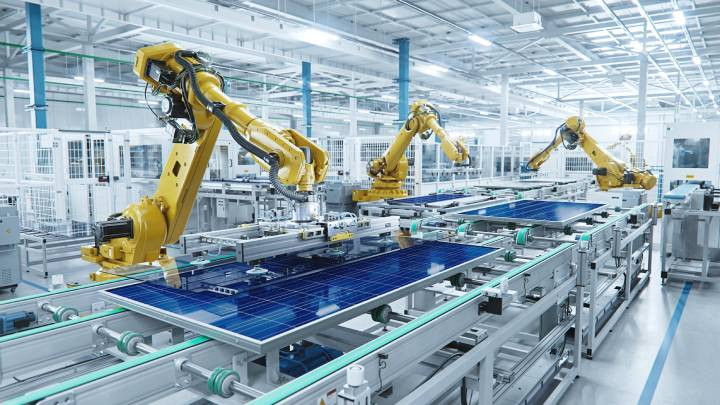What is an Embedded System? From Basics to AI Powerhouses
Educational | 16-10-2023 | By Gary Elinoff
Computers, including Windows, Apple, and Linux devices, are familiar to everyone. But did you know that this is NOT where the vast majority of microprocessors end up being employed?
Dell Technologies[1] states that while 349 million PCs were shipped in 2021, a whopping 39 billion microprocessors (MPUs) were produced. That means that almost 99% went into non-PC devices and are principally designed into embedded systems of every sort. And they are everywhere. They control kitchen appliances and TVs, and they are the brains behind medical devices, ATMs, and digital watches. Modern gas-powered vehicles and their vastly improved mileage would not be possible without multiple internal embedded systems. In this vast landscape of microprocessors, companies like Arm play a pivotal role. As a global leader in CPU technology, Arm's processors are foundational in various sectors, including IoT, AI, Automotive, and Mobile Computing.
Just what are Embedded Systems?
In its simplest form, an embedded system consists of the MPU, a sensor to observe a specific real-world condition, and an electrical actuator. The MPU quizzes the sensor, or the sensor might alert the MPU to a specific condition. Based on the reading, the MPU will activate an electrical actuator that affects a real-world condition. An example would be a thermostatic regulator in a refrigerator. But even in this most simple example, an error-prone mechanical system is replaced with far less expensive electronic control.
Of course, a more complex embedded system would employ multiple sensors that present multiple inputs to the MPU, and the MPU chooses a course of action that depends on the inputs and perhaps makes specific responses based on information stored in memory. It may also receive inputs from the other embedded systems that are part of the vehicle or appliance in which it resides. Or, it could respond to inputs from a human-activated touch screen. Increasingly, modern embedded systems now employ artificial intelligence (AI), but more about that later.
An embedded system can be contained within a single silicon chip, and it could then be described as a system on a chip (SOC). An embedded system can also be composed of many chips. The advantage of a SOC is that because everything is located on one chip, space is saved, and power is conserved. Because of the expense involved in the design and production of a unique silicon chip of any kind, SOCs are preferred when large numbers of the specific embedded system derived will be needed. This is an appropriate strategy when building Edge Computing applications for the Internet of Things (IoT) or if the embedded system will be employed in other high-volume applications such as kitchen appliances, automobiles, or mobile devices.
As described by Dell Technologies[1], embedded systems can be said to fall into one of the three categories illustrated below.

Embedded system categories. Image source: Dell Technologies
- Subsystem: Part of an overall device, like an auto’s instrument cluster
- Standalone: An embedded system that performs its tasks autonomously, such as a calculator or an older iPod
- Network: Interconnected embedded systems, with the connections established through an internal physical system bus, Wi-Fi, 5G, or the internet.
The evolution of embedded systems has been monumental, driven by technological advancements. From the miniaturization of components to the surge in processing capabilities, these systems have transformed significantly. Today, they're not just limited to basic tasks but are capable of making intelligent decisions, thanks to the integration of AI and machine learning.
ARM Processors
But wait, aren’t CPUs discrete silicon devices themselves? Not always! In developing a SOC, you obviously can’t employ a separate physical chip, but you can employ its design. Here’s where ARM processors [2] may well come in. ARM was one of the first companies that designed chips but didn’t physically produce them; rather, they offer the intellectual property (IP) necessary to fabricate the device. The manufacturer will pay for a license to use the ARM design, and the purchase package includes everything needed to burn a functioning ARM processor onto a target chip. Again, this saves time, money, space, and power.
Understanding ARM Processors
ARM processors, standing for Advanced RISC Machine, are central processing units (CPUs) that operate on a reduced instruction set computer (RISC) architecture. This architecture is distinct from the more common server architectures like x86.
Originally rooted in microcomputing, ARM's evolution is closely tied with the progression of computer chips and the RISC architecture. Unlike the modular approach of x86 designs where components can be swapped, ARM-based processors integrate the CPU cores with other hardware components on the same physical platform, creating a system on a chip (SOC).
One of the standout features of ARM architectures is their prevalence in electronic designs globally. They are especially dominant in smartphones, mobile devices, and laptops. This is attributed to their ability to strike a balance between cost, size, power consumption, speed, and potentially longer battery life.
It's essential to note that ARM Holdings doesn't produce hardware. Instead, they provide designs, allowing manufacturers to tailor the microarchitecture to their specific requirements. This flexibility offers hardware designers greater control over their designs, performance, and supply chains, making ARM architectures appealing for a range of devices, from small consumer electronics to large-scale computing environments.
Reduced Instruction Set - RISC
The company name “ARM” stands for Advanced RISC Machine, with ARM and RISC growing up together. As described by Red Hat[3], “Processing units have certain predefined operations collectively called instruction sets. Operating systems and programs use those instruction sets to execute themselves. What programmers at Berkeley found was that most programs used only a small subset of the instruction set. If they reduced the number of predefined instructions—cutting out complex and hard to implement (and little used) instructions —the remaining simple instructions would run faster and take up much less power and space on the chip. This is called reduced instruction set computer (RISC) architecture.”
RISC can be contrasted with CISC or Complex Instruction Set Computing. Windows is an example of a CISC operating system. CISC instructions can do more in each step than RISC can, but they do it much more slowly and with more overhead. ARM processors are specifically designed to run RISC instruction sets.
An embedded system designer will strive to remove bloat. He will use an RISC processor, ARM or otherwise, that includes as few unneeded instructions as possible. In a similar manner, he will choose a RISC system that offers what he needs but as little extra as possible. The embedded system, whether a SOC or a collection of separate components, will take up as little physical space as possible, use the minimum amount of power, and run faster than a system bogged down by unnecessary complexity.
Embeddable AI
As described by Hewlett Packard[4], “Artificial intelligence (AI) broadly refers to any human-like behavior displayed by a machine or system. In AI’s most basic form, computers are programmed to “mimic” human behavior using extensive data from past examples of similar behavior. For instance, when you ask Siri or Alexa a question, the AI processes your voice, understands the query, and provides an answer based on its programming and learning. This is a practical application of AI in our daily lives, where machines are trained to understand and respond to human interactions.”
When designing an edge computing system, it is always desirable to have as much decision-making as possible and as close to the “edge” as possible. To make this paradigm a reality, AI is being built into embedded systems. In this manner, the embedded system does not have to send a large amount of raw data to a centrally located AI engine. This is even more critical if that AI engine is located thousands of miles away and can only be accessed via the cloud.
Now, let's delve deeper. Why is AI such a hot topic today? Beyond voice assistants, AI powers recommendation engines on platforms like Netflix or Spotify, suggesting movies or songs based on our preferences. In healthcare, AI algorithms analyze medical images to detect diseases, sometimes with higher accuracy than human experts. Well, in the simplest terms, AI is like teaching machines to think and act like us, humans. Imagine a computer distinguishing between a cat and a bird or even making decisions in a bustling factory. That's AI for you! It's all about making swift decisions when the clock's ticking.
Ecosystem Impact: Arm's vast ecosystem has been instrumental in its success. This ecosystem, comprising developers, manufacturers, and other stakeholders, accelerates the adoption and evolution of technology. In the context of embedded systems, a robust ecosystem can drive innovation, leading to more advanced and interconnected systems.
TI (Texas Instruments) advocates enabling artificial intelligence in every embedded system, which allows for decisions to be made “in the moment.”
Future Trends in Embedded Processing
Embedded processing, the heart of many modern devices, is undergoing a rapid transformation. As we gaze into the horizon, three pivotal trends emerge, reshaping the landscape of embedded technology:
- AI and Machine Learning Take Center Stage: Gone are the days when AI and machine learning (ML) were mere buzzwords. They've transitioned from being the talk of the town to becoming the backbone of numerous embedded systems. Whether it's the voice recognition in our smart speakers or the predictive analytics in industrial machinery, AI and ML are ushering in an era of smarter, more efficient systems. This evolution demands processors that aren't just powerful but are adept at handling the intricate computations intrinsic to AI and ML.
- The Dawn of Edge Computing: With the proliferation of connected devices, there's a discernible shift towards processing data at the edge, right where it's generated. This not only trims down latency and sharpens response times but also curtails the volume of data transmitted over networks. What's essential for edge computing? Processors that pack a punch in terms of power, yet are frugal enough on the energy front to operate on batteries when needed.
- Security Takes the Front Seat: Connectivity is a double-edged sword. As embedded systems become more intertwined with the web, they're also more exposed to potential cyber threats. This underscores the pressing need for fortified security in embedded processing. The processors of tomorrow need to be not just powerful and efficient but also fortified with robust security features to ward off potential cyber threats.
These transformative trends are not just reshaping the future of embedded processing; they're defining it. At Texas Instruments, innovation is at the core of what we do. Our embedded processors are meticulously crafted to cater to the next-gen smart devices, striking the right balance between performance, efficiency, and security.

Embedded systems on the factory floor. Image source: Texas Instruments[5]
TI describes a situation involving “cameras throughout a factory continuously inspecting equipment to detect and predict faults in machinery. Sending that data outside the local network to the cloud, then waiting for it to be processed and analyzed for a decision to stop the assembly line could compromise quality and throughput of the assembly line while increasing total costs. By incorporating intelligence at the edge, the assembly process can be halted in a split second, if needed.”
Connectivity has further broadened the horizons for embedded systems. With the rise of the Internet of Things (IoT), these systems can now communicate and collaborate with a myriad of other devices, creating a more interconnected and efficient ecosystem.
But wait, there's more to AI. Ever heard of Machine Learning or Deep Learning? They're like the younger siblings of AI. While AI is the grand idea of machines mimicking human intelligence, Machine Learning is about recognizing patterns and learning from data. And then there's Deep Learning, the prodigy, using complex artificial neural networks to sometimes even outdo human capabilities. Mind-blowing, right?
Today, AI isn't just a fancy term. It's becoming a part of our daily grind. From businesses to daily chores, AI is making its mark. And with 50% of industries gearing up for AI, it's clear that this is just the beginning of an AI-driven era.
Challenges and Opportunities
Security is a major problem with anything involving data transfer over the internet, as many embedded systems must do. By having most decisions made locally thanks to embedded AI, the sheer volume of valuable data potentially available for malefactors to hijack is very substantially reduced.
The rapid proliferation of 5G technology will have a tremendous impact on embedded systems and what they can achieve.

The availability of 5G communications will add to the capabilities of Embedded Systems. Image source: Indian Institute of Embedded Systems[6]
As described by the Indian Institute of Embedded Systems[6], “5G could enable the widespread adoption of smart homes, where all devices are connected to a central network and can be controlled remotely. 5G could also enable the widespread adoption of autonomous vehicles, where vehicles communicate with each other and with the surrounding environment to ensure safe and efficient operation.”
Wrapping Up
Embedded systems are built around the idea of local control of real-world situations, with as little reference as possible to a nearby data engine, much less on a data engine located far away and only accessible via the internet. This philosophy of localized decision-making is also emphasized by Arm, which underscores the significance of localized processing to reduce latency and ensure efficient operations. The synergy between hardware, like Arm's processors, and the embedded system's design philosophy can lead to safer, faster, and more resilient systems.
If the embedded system contains localized AI, as more and more embedded systems do, more decisions can be made locally, on the spot. The result is safer, more resilient systems that operate faster and with more efficiency.
A trip down memory lane would reveal that AI has come a long way. From computers playing checkers to AI-driven cars and healthcare solutions, we've truly come of age. And guess what? The AI journey is categorized into some fascinating types:
- Reactive Machine: These are the old-school ones, reacting without learning from the past.
- Limited Theory: A bit smarter, using past experiences for better decisions.
- Theory of Mind: The future! Aimed at understanding human emotions and thoughts.
- Self-Aware AI: The dream! Machines that not only think but also feel.
However, with great power comes great responsibility. As embedded systems become more advanced and connected, ensuring their security is crucial. Protecting these systems from potential threats and breaches is of utmost importance, given their widespread applications and the critical roles they play in various sectors. In this context, Arm offers products like TrustZone and SecurCore to ensure secure operations, highlighting the industry's focus on safeguarding these critical systems.
References:
1. THE HIDDEN WORLD OF EMBEDDED SYSTEMS. DELL Technologies
2. ARM is Building the Future of Computing. ARM Holdings
3. What is an ARM Processor? Red Hat
4. What is Artificial Intelligence? Hewlett Packard
5. 3 trends impacting the future of embedded processing technology. Texas Instruments
6. The impact of 5G on the future of embedded systems. Indian Institute of Embedded Systems
Glossary
AI: artificial intelligence
ARM: A company that sells manufacturers the rights to fabricate its Advanced RISC Machine (ARM) designs
CISC: Complex instruction set computing
IP: intellectual property
RISC: Reduced instruction set computer
SOC: System on a chip

